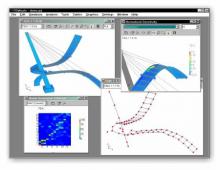|
Advanced Finite Element Solutions for Simulating Dynamic Response and Structural Modifications FEMtools Dynamics contains tools for:
|
|
Frequency Response Functions (FRF) To obtain FRFs, the response function is divided by the excitation force. Because these functions do not contain force information, they only depend on mass, stiffness and damping properties of the structure, just like the modal properties. Therefore they are also suitable as responses for correlation analysis, sensitivity analysis and model updating. Key Features
|
|
Harmonic Response Analysis Harmonic response analysis studies the response of a structure under harmonic loading all of the applied forces are known at each forcing frequency. Depending on the formulation, operational displacement, velocities or accelerations are obtained. In general, the results are referred to as Operational Shapes or Operational Displacement Shapes (ODS). ODS can be used in correlation analysis to compare experimental ODS with analytical predictions. Key Features
|
|
Residual Vectors Residual Vectors (RESVEC) are used to extend the modal base that is used for modal superposition methods. They can compensate the effects of modal truncation and often improve the dynamic response without the need to increase the number of mode shapes or use a direct method. FEMtools supports methods to compute residual vectors that are based on inertia relief, viscous damping and applied loads. |

